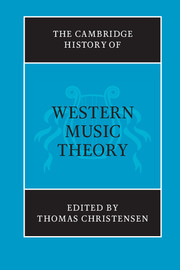11 - Notes, scales, and modes in the earlier Middle Ages
from A - Mapping tonal spaces
Published online by Cambridge University Press: 28 March 2008
Summary
The basis of most musical instruction, thought, and activity in the Western world is a particular conceptualization of pitch. We understand musical pitches as distinct sonic entities (“discrete pitch”), specifiable by name, and we mentally represent them as a series of points occupying higher or lower, intervallically defined positions on an imaginary, quasi-spatial, vertically aligned two-dimensional continuum – or basic “pitch space.” (We may also conceive the positions as defined by absolute pitch, determined by vibrational frequencies; this modern concept will not be considered here.) The pitches, or as I shall usually call them, “notes,” constitute a system defined by various intervallic and other relationships and comprising a multitude of specific structures, including our familiar major, minor, and chromatic scales. These conceptualizations of discrete pitch, pitch space, and pitch-intervallic scalar system have their ultimate origins in the music theory of Greek antiquity. But the particular scale system we use is the result of a long historical evolution, in which the most crucial developments occurred in the ninth and eleventh centuries. Sections I and II of this chapter, respectively, will provide a fairly detailed examination of those developments, together with others to which they are closely connected, especially those concerning the early stages of pitch notation, solmization, and the theoretical systematization of the church modes. Section III, a brief postscriptum, will indicate some of the developments of the later Middle Ages and early Renaissance, to c. 1500.
Information
- Type
- Chapter
- Information
- The Cambridge History of Western Music Theory , pp. 305 - 363Publisher: Cambridge University PressPrint publication year: 2002
References
Accessibility standard: Unknown
Why this information is here
This section outlines the accessibility features of this content - including support for screen readers, full keyboard navigation and high-contrast display options. This may not be relevant for you.Accessibility Information
- 12
- Cited by
